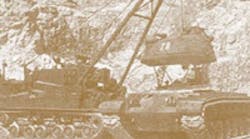50 years ago ...
From the May 1954 issue of Applied Hydraulics (the original title of H&P).
Designers of the recovery vehicle, Bowen-McLaughlin-York Inc., had to obtain a hydraulic circuit that could withstand the most severe type of service expected from a mobile unit. The recovery vehicle is a rebuilt, outmoded World War II tank. Army ordnance decided that instead of scrapping these obsolete tanks they should be rebuilt and used to rescue damaged tanks to prevent capture or destruction by the enemy.
Redesign of the medium tank was quite a job because it had to be able to rescue newer and larger tanks under combat conditions. Converted to a tank wrecker, the T47 weighs nearly 50 tons and has enough power to rescue any tank or vehicle up to 45 tons. The hydraulic system that powers the recovery vehicle is capable of towing, as well as hoisting and winching, a tank out of mud and deep ditches, or flipping upright an overturned tank.


